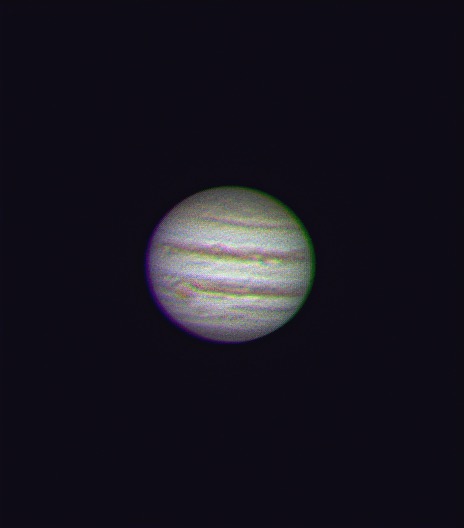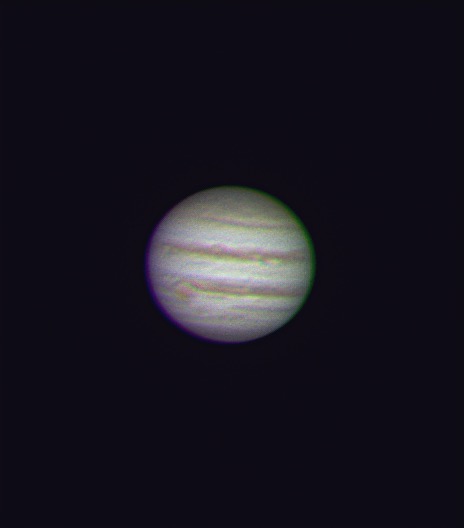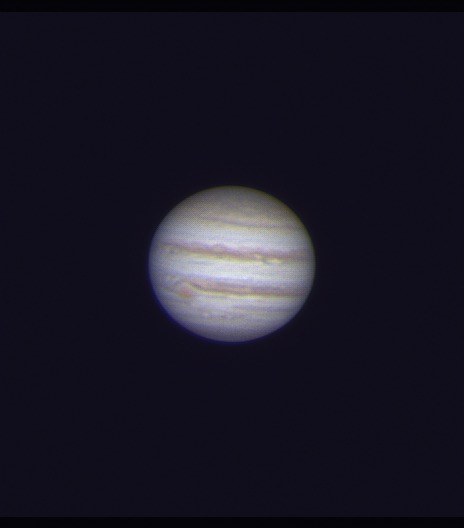




Description:
Jupiter is the fifth and largest planet in our Solar System. It is a gas giant with a mass more than two and a half times that of all the other planets in the Solar System combined, and slightly less than one one-thousandth the mass of the Sun. Jupiter orbits the Sun at a distance of 5.20 AU (778.5 Gm) with an orbital period of 11.86 years. Jupiter has a diameter of 142,984 km (88,846 mi) at its equator, giving it a volume 1,321 times that of the Earth. It’s mass is 318 times larger than the earth’s. Because of it’s gravity, Jupiter’s core continues to contract. At the time of its formation, Jupiter was hotter and was about twice its current diameter.
Jupiter began as a solid core, which then accumulated its gaseous atmosphere. The planet is primarily composed of hydrogen (90% by volume), followed by helium, which makes up a quarter of its mass and a tenth of its volume. The atmosphere also contains trace amounts of methane, water vapour, ammonia, and silicon-based compounds, as well as fractional amounts of carbon, ethane, hydrogen sulfide, neon, oxygen, phosphine, and sulfur. The outermost layer of the atmosphere contains crystals of frozen ammoniaThe ongoing contraction of Jupiter’s interior generates more heat than the planet receives from the Sun. Its internal structure is believed to consist of an outer mantle of fluid metallic hydrogen, and a diffuse inner core of denser material. Because of its rapid rotation rate of 1 rotation per 10 hours, Jupiter’s shape is an oblate spheroid: it has a slight but noticeable bulge around the equator. The outer atmosphere is divided into a series of latitudinal bands, with turbulence and storms along their interacting boundaries. The most obvious result of this is the Great Red Spot, a giant storm which has been observed since 1831 and possibly earlier.
Data from the Juno mission showed that Jupiter has a diffuse core that mixes into its mantle, extending for 30–50% of the planet’s radius, and comprising heavy elements with a combined mass 7–25 times the Earth. This mixing process could have arisen during formation, while the planet accreted solids and gases from the surrounding nebula. Alternatively, it could have been caused by an impact from a planet of about ten Earth masses a few million years after Jupiter’s formation, which would have disrupted an originally solid Jovian core. Outside the layer of metallic hydrogen lies a transparent interior atmosphere of hydrogen. At this depth, the pressure and temperature are above molecular hydrogen’s critical pressure of 1.3 MPa and critical temperature of 33 K (−240.2 °C; −400.3 °F). The hydrogen and helium gas extending downward from the cloud layer gradually transitions to a liquid in deeper layers, possibly resembling something akin to an ocean of liquid hydrogen and other supercritical fluids, gradually becoming hotter and denser as depth increases. Rain-like droplets of helium and neon precipitate downward through the lower atmosphere, depleting the abundance of these elements in the upper atmosphere. Rainfalls of diamonds have been suggested to occur, as well as on Saturn and the ice giants Uranus and Neptune. At a surface depth where the atmospheric pressure level is 1 bar (0.10 MPa), the temperature is around 165 K (−108 °C; −163 °F). The region where supercritical hydrogen changes gradually from a molecular fluid to a metallic fluid spans pressure ranges of 50–400 GPa with temperatures of 5,000–8,400 K (4,730–8,130 °C; 8,540–14,660 °F), respectively. The temperature of Jupiter’s diluted core is estimated to be 20,000 K (19,700 °C; 35,500 °F) with a pressure of around 4,000 GPa.
Jupiter is surrounded by a faint planetary ring system and has a powerful magnetosphere, the second largest contiguous structure in the Solar System (after the heliosphere). Jupiter forms a system of 95 known moons and probably many more, including the four large moons discovered by Galileo Galilei in 1610: Io, Europa, Ganymede, and Callisto. Ganymede, the largest of the four, is larger than the planet Mercury. Callisto is the second largest; Io and Europa are approximately the size of Earth’s Moon.
Image capture:
Image processing:
Comments:
Leave a Reply